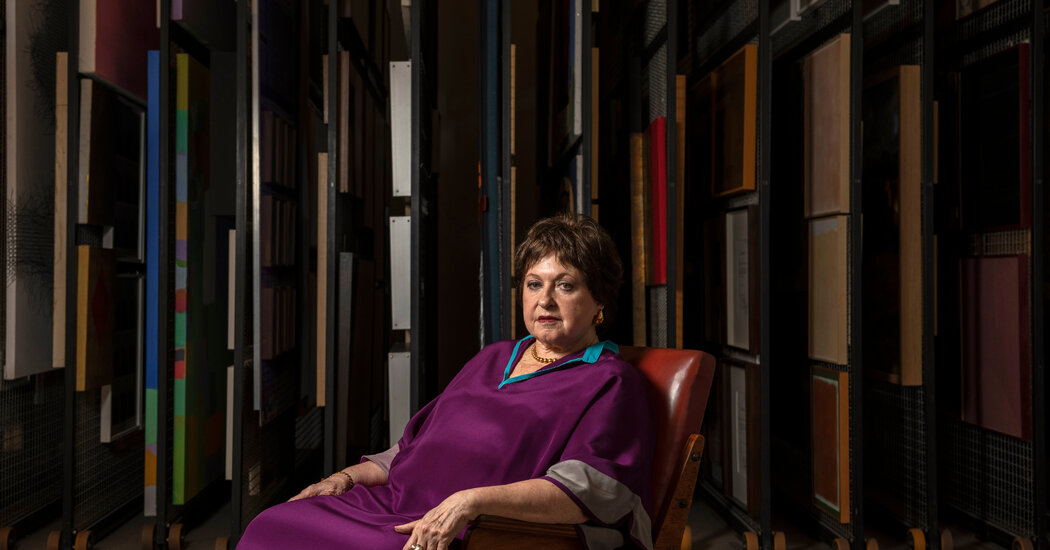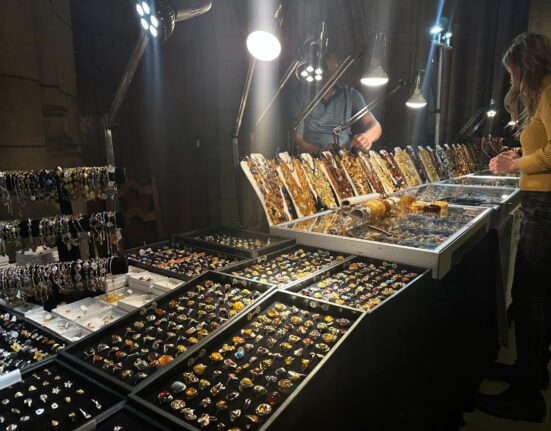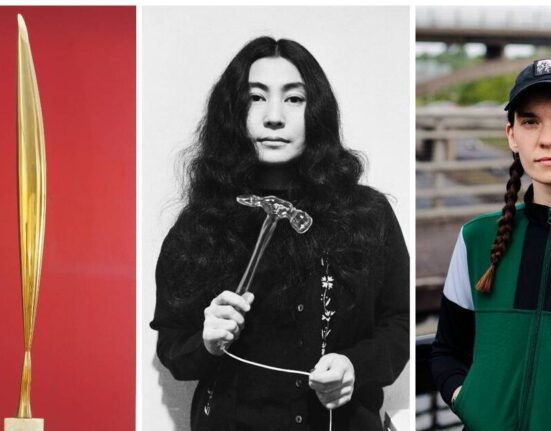During her decades in the gallery business, Luisa Strina has earned a reputation for both her keen eye — and her clear opinions — about contemporary art. She knows what she likes and the type of art that sells under her brand, she said, and does not waste words appeasing the egos of artists or customers who do not understand the mission.
Ms. Strina, 80, is known for being direct — “maybe too direct sometimes,” she said — but also for getting things right. Scores of collectors have relied on her taste for a half century, making Galeria Luisa Strina one of the most successful, and respected, art dealers in Brazil. This week, she will be showing a slate of mostly Brazilian artists at Art Basel Miami Beach, and next month begins her 50th year as a dealer, a milestone for any gallery, but particularly in Latin America, where the contemporary art business, with its urbane showrooms and fashionable art fairs, took shape later than it did in the United States and Europe.
“In this business sometimes you have to be tough, of course you do,” she said during an interview at her gallery, located among the designer retail shops and high-cuisine cafes in São Paulo’s Jardins neighborhood. Ms. Strina had returned from an art fair in Paris only a day ago and was preparing for another, in New York, a week later. As she spoke, a crew of workers was disassembling a recent exhibition, leaving the gallery space — a single, rectangular room with tall, white walls and a polished concrete floor — feeling empty and full of echoes.
As a mantra for success, being a tough judge of talent might sound a bit heavy handed — if it were not for the fact that the first artist she turned her gaze upon, and rejected, was herself. That happened during the first year in college when she was studying painting, dreaming of turning it into a career. Ms. Strina did not recognize a great talent in the making.
“By the second year, I gave it up,” she said. “I saw it was not my piece of cake.”
She did have an appreciation for the skilled people around her, though. She began selling the work of her teachers and fellow students, setting up pop-up exhibits around São Paulo. It was a side job, nothing serious.
Then one day, a friend suggested she take over a studio he was vacating and turn it into a permanent shop. It was modest, but in the heart of Jardins, just as the area was establishing itself as a center for the city’s cultural scene, she said. She accepted the challenge, opening Galeria Luisa Strina in 1974.
“And so that’s how I started,” she said. “I didn’t know much about being a gallerist then. I learned by myself.”
At first, her gallery showed artists primarily from Rio de Janeiro and other Brazilian cities before eventually expanding to artists from different countries. Thinking back on those early days, the Brazilian British artist Alexandre da Cunha remembers that her place had a hip, ahead-of-the-curve vibe.
“I used to go to her gallery when I was an art student. It was the hangout for all of the most interesting people in São Paulo,” said Mr. da Cunha, now in his 50s, who went on to develop his own successful career, formally joining the gallery’s roster in 2000.
He added: “All the good artists, at some point, showed with Luisa. And she was one of the first galleries in Brazil showing international people.”
Simultaneously, she was bringing Brazil to the world. In the late 1980s, she began to do exhibitions at small art fairs in places like New York and Los Angeles. “You stayed in the hotel, you rented a room and invited people in,” she said.
In 1991, she took her first booth at a major fair, Art Basel in Switzerland, becoming the first gallery from Latin America to join the lineup.
Ms. Strina has backed some winners during her career. She was an early champion of the artist Cildo Meireles, who started with the gallery when he was little-known and went on to global success, with works acquired by the Museum of Modern Art, in New York; the Museum of Contemporary Art, in Barcelona; and the Los Angeles County Museum of Art.
Another example is Fernanda Gomes, whom Ms. Strina discovered in Rio at the beginning of her career, and who has now shown in museums and galleries worldwide, placing works in the collections of Tate Modern, in London, and Pérez Art Museum Miami.
Like all of the gallery’s artists, Ms. Gomes makes work that is highly conceptual, and not always easy to sell, though “Luisa never cared about that,” said Kiki Mazzucchelli, a veteran curator who joined the gallery as artistic director in February.
Over the years, Ms. Strina’s own renown grew along with that of her artists. Her gallery built up enough clout to bring on famous names, like the Mexican artist Pedro Reyes and the Icelandic Danish superstar Olafur Eliasson. In 2015, it was selected, along with Pace Gallery and Thaddaeus Ropac, to represent the estate of the American artist Robert Rauschenberg.
Still, Ms. Strina is best known as an advocate of artists from her own country. José Kuri, a founder of Mexico City’s landmark gallery Kurimanzutto, recently referred to her as “the grande dame of Brazilian art.”
Ms. Strina credits her success to having consistent standards. She only takes on conceptual artists. Pretty landscapes turn her off, she said, even though they might be easier to sell. Art needs to be difficult, to challenge viewers’ understanding over time.
She also holds firm to her decisions. Her collaborators tend to stick around for a long time.
The artist Marcius Galan met Ms. Strina in 1997 when he was a student in São Paulo. She saw some of his work and invited him to bring his portfolio by the gallery. “I was super afraid of her at the beginning,” he said.
But she was kind and, not surprisingly, direct, telling him that he was not quite ready and to come back in a year. He did, and she gave him a show. They have been together ever since.
Mr. Galan’s work has the sort of conceptual style that defines Galeria Luisa Strina. He often starts with everyday materials such as push pins, seeds or pencil erasers, arranging them into larger objects that challenge viewers to question their original purpose and consider them fodder for art pieces. His work offers mental and visual challenges, and avoids direct conversation about politics or social issues.
His relationship with his gallerist is one of mutual trust. “Normally, I’m very free to produce,” he said. “Sometimes, I just put my things inside the gallery and she does not see them until the opening.”
Similarly, Mr. da Cunha rarely discusses art with Ms. Strina. They are close friends, he said, but she has never tried to guide his artistic decisions. Mr. da Cunha, who recently moved back to Brazil after several years living in London, is known for both large-scale public projects and smaller works that repurpose common objects. One piece recycles cleaning mops, another redeploys a large metal tumbler from the back of a concrete truck.
“She never says if she likes something or if she doesn’t,” Mr. da Cunha said. “Or that she likes this one thing more than that. She doesn’t say anything, which can also be intimidating.”
Still, Ms. Strina maintains control of the gallery and its reputation, mainly by making decisions upfront on who she takes on, assembling what Mr. da Cunha calls “a tight and very coherent group of artists that together make sense.”
Looking over her roster, it is easy to see what he means. Consider one of Galeria Luisa Strina’s current stars, Clarissa Tossin, an artist raised in Brasília who is also known as a recycler of ordinary things. Ms. Tossin has widely exhibited her series of wall-hangings made from Amazon delivery boxes that she cuts into strips and turns into weavings that explore Brazil’s social and economic history.
Everything comes together under that same keen eye. “Luisa really understands what’s important, what’s avant-garde,” Ms. Mazzucchelli said.
And what fits into Galeria Luisa Strina. “People identify the gallery with her as a person. The two things are really intertwined,” Ms. Mazzucchelli added.
As for the future, Ms. Strina said she has no desire to retire. She likes the work, the travel and is content spending time in her gallery and its back office, which she has decorated with works from her stable of artists and people she has met. She has hung one of Ms. Tossin’s weavings on her wall, and there is a wooden chair she likes that was designed by the Brazilian modernist architect Lina Bo Bardi.
She is proud of what she has accomplished, she said, and it is more than she expected as the daughter of Italian immigrants who came to Brazil to start a new life. Her plan, she said, is to keep selling art until she “falls over on the desk.”
“I was always privileged, because I had a good education,” she said. “I was happy to do what I wanted. I always imagine those people that work in factories and have to do the same thing all of the day.”
That has not been her fate: “On the worst days that I had in my life, I always had art to participate with.”







